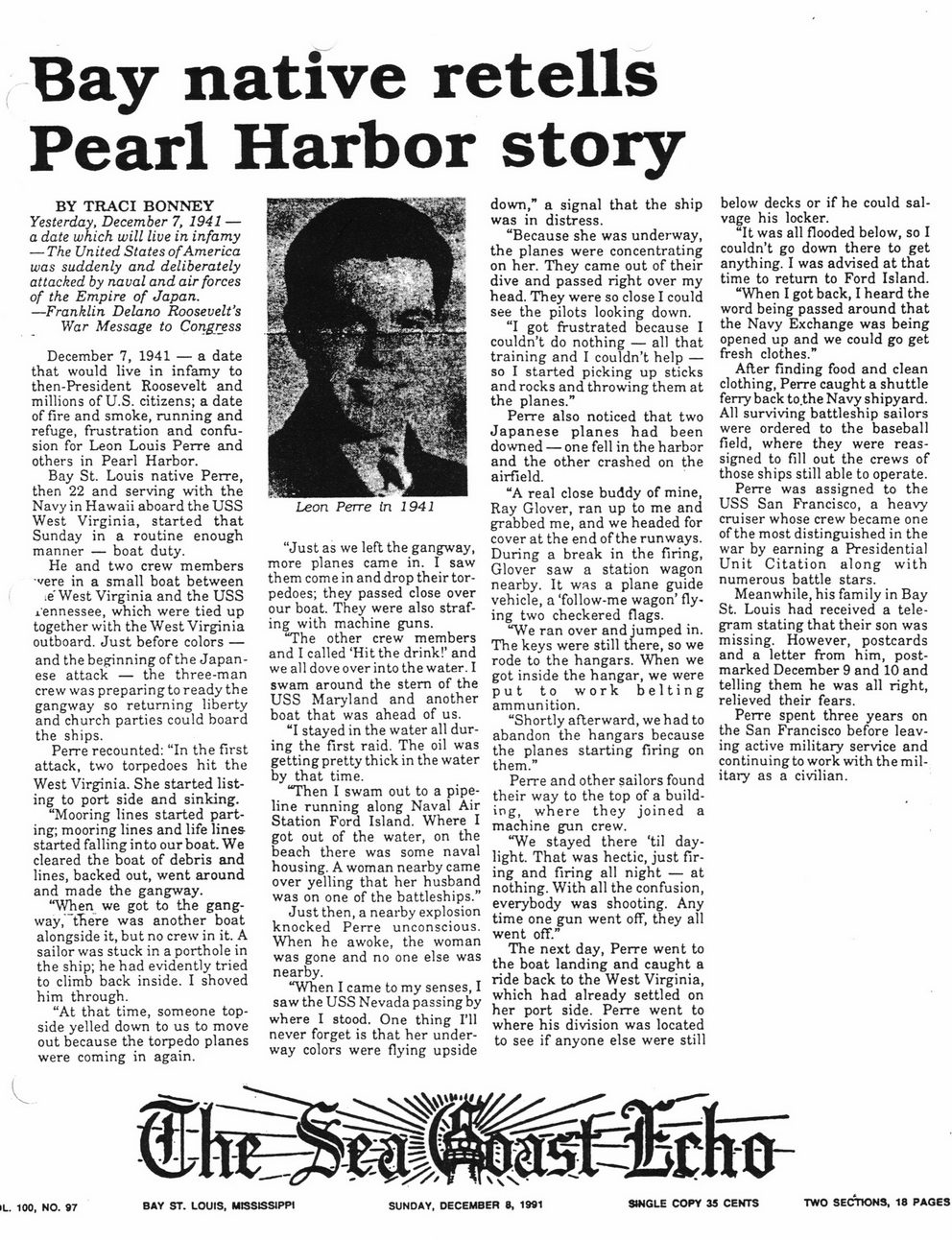This text was obtained via automated optical character recognition.
It has not been edited and may therefore contain several errors.
Bay native retells Pearl Harbor story BY TRACI BONNEY Yesterday, December 7, 1941 ? a date which will live in infamy ? The United States of America was suddenly and deliberately attacked by naval and airforces of the Empire of Japan. ?Franklin Delano Roosevelt?s War Message to Congress December 7, 1941 ? a date that would live in infamy to then-President Roosevelt and millions of U.S. citizens; a date of fire and smoke, running and refuge, frustration and confusion for Leon Louis Perre and others in Pearl Harbor. Bay St. Louis native Perre, then 22 and serving with the Navy in Hawaii aboard the USS West Virginia, started that Sunday in a routine enough manner ? boat duty. He and two crew members vere in a small boat between ^e'West Virginia and the USS Tennessee, which were tied up together with the West Virginia outboard. Just before colors ? and the beginning of the Japanese attack ? the three-man crew was preparing to ready the gangway so returning liberty and church parties could board the ships. Perre recounted: ?In the first attack, two torpedoes hit the West Virginia. She started listing to port side and sinking. ?Mooring lines started parting; mooring lines and life lines-started falling into our boat. We cleared the boat of debris and lines, backed out, went around and made the gangway. ?When we got to the gangway, there was another boat alongside it, but no crew in it. A sailor was stuck in a porthole in the ship; he had evidently tried to climb back inside. I shoved him through. ?At that time, someone topside yelled down to us to move out because the torpedo planes were coming in again. Leon Perre in 1941 ?Just as we left the gangway, more planes came in. I saw them come in and drop their torpedoes; they passed close over our boat. They were also strafing with machine guns. ?The other crew members and I called ?Hit the drink!? and we all dove over into the water. I swam around the stem of the USS Maryland and another boat that was ahead of us. ?I stayed in the water all during the first raid. The oil was getting pretty thick in the water by that time. ?Then I swam out to a pipeline running along Naval Air Station Ford Island. Where I got out of the water, on the beach there was some naval housing. A woman nearby came over yelling that her husband was on one of the battleships.? Just then, a nearby explosion knocked Perre unconscious. When he awoke, the woman was gone and no one else was nearby. ?When I came to my senses, I saw the USS Nevada passing by where I stood. One thing I?ll never forget is that her underway colors were flying upside down,? a signal that the ship was in distress. ?Because she was underway, the planes were concentrating on her. They came out of their dive and passed right over my head. They were so close I could see the pilots looking down. ?I got frustrated because I couldn?t do nothing ? all that training and I couldn?t help ? so I started picking up sticks and rocks and throwing them at the planes.? Perre also noticed that two Japanese planes had been downed ? one fell in the harbor and the other crashed on the airfield. ?A real close buddy of mine, Ray Glover, ran up to me and grabbed me, and we headed for cover at the end of the runways. During a break in the firing, Glover saw a station wagon nearby. It was a plane guide vehicle, a ?follow-me wagon? flying two checkered flags. ?We ran over and jumped in. The keys were still there, so we rode to the hangars. When we got inside the hangar, we were put to work belting ammunition. ?Shortly afterward, we had to abandon the hangars because the planes starting firing on them.? Perre and other sailors found their way to the top of a building, where they joined a machine gun crew. ?We stayed there ?til daylight. That was hectic, just firing and firing all night ? at nothing. With all the confusion, everybody was shooting. Any time one gun went off, they all went off.? The next day, Perre went to the boat landing and caught a ride back to the West Virginia, which had already settled on her port side. Perre went to where his division was located to see if anyone else were still below decks or if he could salvage his locker. ?It was all flooded below, so I couldn?t go down there to get anything. I was advised at that time to return to Ford Island. ?When I got back, I heard the word being passed around that the Navy Exchange was being opened up and we could go get fresh clothes." After finding food and clean clothing, Perre caught a shuttle ferry back to the Navy shipyard. All surviving battleship sailors were ordered to the baseball field, where they were reassigned to fill out the crews of those ships still able to operate. Perre was assigned to the USS San Francisco, a heavy cruiser whose crew became one of the most distinguished in the war by earning a Presidential Unit Citation along with numerous battle stars. Meanwhile, his family in Bay St. Louis had received a telegram stating that their son was missing. However, postcards and a letter from him, postmarked December 9 and 10 and telling them he was all right, relieved their fears. Perre spent three years on the San Francisco before leaving active military service and continuing to work with the military as a civilian. L. 100, NO. 97 BAY ST. LOUIS, MISSISSIPPI SUNDAY, DECEMBER 0, 1991 SINGLE COPY 35 CENTS TWO SECTIONS, 18 PAGES

Perre (Perry) 010